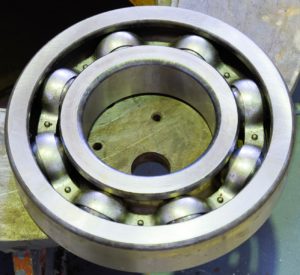We are going to describe the steps we follow in GDM to repair a spindle. With these articles we want to explain to you how we proceed to repair the engines that come to us from our clients. Always respecting the most scrupulous safety and quality measures. We always want to give the highest standard of quality and reliability in our repairs. The equipment that comes to us leaves our facilities in perfect condition and complying with the manufacturer’s specifications.
Initial checks for a spindle repair.
The first step in spindle or spindle repair is to check the winding or stator. This test is done to determine if there are leads or shorts. In the event that this were the problem, the winding would be replaced. This solution would occur regardless of whether the winding was encapsulated or not.
The next step would be to check the proper functioning of the encoder. Also in this step the revision of the tool clamping sensors would be carried out.
Subsequently, it would be checked that the axis cone did not have any type of jump, that is, deviations of the tool. And it would also be verified that the clamping force of the clamp is adequate for the tool.
Engine disassembly.
After carrying out all the initial checks, and after correcting what is necessary, we proceed to the disassembly phase.
This would allow us to verify the need to replace O-rings that guarantee watertightness against the flow of water. In addition, all the rectified parts of the engine would be checked.
 Another of the important pieces are the bearings, since they will work at very high revolutions. It should also be borne in mind that they will have to withstand high loads. The bearing is a sensitive part as it has a key mounting position. We must not forget that they must also be subjected to a very specific tightening torque, which is called preload. The mounting of the bearing is key, since a failure in its mounting cancels the correct operation of the motor.
Another of the important pieces are the bearings, since they will work at very high revolutions. It should also be borne in mind that they will have to withstand high loads. The bearing is a sensitive part as it has a key mounting position. We must not forget that they must also be subjected to a very specific tightening torque, which is called preload. The mounting of the bearing is key, since a failure in its mounting cancels the correct operation of the motor.
Final tests.
Once all the checks and repairs have been carried out, we proceed to the final tests. For this we have test benches for most of the brands and types of engines on the market.
On the test benches we will subject the engines to work tests. The tests are carried out both in a vertical and horizontal position, depending on the working design of the motor.
The break-in the engine is subjected to on the test bench consists of having it running at certain revolutions during specific test times. In this way, data on vibrations, working temperature, motor consumption and other key variables are obtained. In this way, the perfect working condition of the engine is guaranteed.
After finishing the running tests, the clamping force of the cone is checked again. The object is to ensure that there are no tool jumps or vibrations on the shaft.
To finish, we proceed to the total cleaning of the engine and a paint treatment. After all these processes, the engine returns to its original state and under all manufacturer specifications.
There is only one last step left, the packaging of the motor. For transport to origin, the engine is properly prepared in a box that guarantees the elimination of risks. Perfectly padded wooden boxes to avoid all kinds of accidents in such sensitive and expensive equipment.
As you have seen in GDM we are scrupulous with the quality of our repairs. Here we leave you a video where we explain all this process. And if you need any kind of clarification or that we give you more information about our repair processes, you can write to us FROM HERE.


